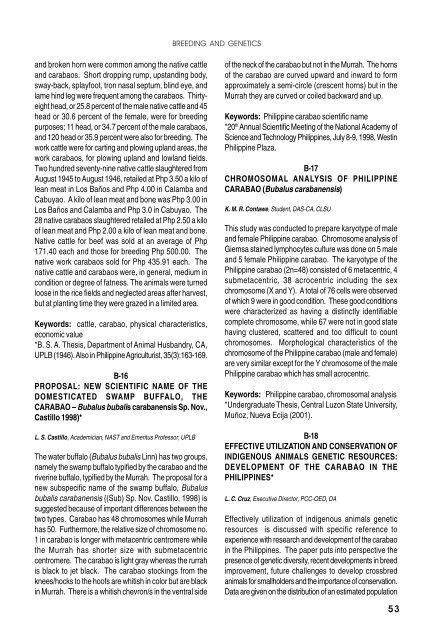THE PHILIPPINE WATER BUFFALO
THE PHILIPPINE WATER BUFFALO
THE PHILIPPINE WATER BUFFALO
You also want an ePaper? Increase the reach of your titles
YUMPU automatically turns print PDFs into web optimized ePapers that Google loves.
and broken horn were common among the native cattle<br />
and carabaos. Short dropping rump, upstanding body,<br />
sway-back, splayfoot, tron nasal septum, blind eye, and<br />
lame hind leg were frequent among the carabaos. Thirtyeight<br />
head, or 25.8 percent of the male native cattle and 45<br />
head or 30.6 percent of the female, were for breeding<br />
purposes; 11 head, or 34.7 percent of the male carabaos,<br />
and 120 head or 35.9 percent were also for breeding. The<br />
work cattle were for carting and plowing upland areas, the<br />
work carabaos, for plowing upland and lowland fields.<br />
Two hundred seventy-nine native cattle slaughtered from<br />
August 1945 to August 1946, retailed at Php 3.50 a kilo of<br />
lean meat in Los Baños and Php 4.00 in Calamba and<br />
Cabuyao. A kilo of lean meat and bone was Php 3.00 in<br />
Los Baños and Calamba and Php 3.0 in Cabuyao. The<br />
28 native carabaos slaughtered retailed at Php 2.50 a kilo<br />
of lean meat and Php 2.00 a kilo of lean meat and bone.<br />
Native cattle for beef was sold at an average of Php<br />
171.40 each and those for breeding Php 500.00. The<br />
native work carabaos sold for Php 435.91 each. The<br />
native cattle and carabaos were, in general, medium in<br />
condition or degree of fatness. The animals were turned<br />
loose in the rice fields and neglected areas after harvest,<br />
but at planting time they were grazed in a limited area.<br />
Keywords: cattle, carabao, physical characteristics,<br />
economic value<br />
*B. S. A. Thesis, Department of Animal Husbandry, CA,<br />
UPLB (1946). Also in Philippine Agriculturist, 35(3):163-169.<br />
B-16<br />
PROPOSAL: NEW SCIENTIFIC NAME OF <strong>THE</strong><br />
DOMESTICATED SWAMP <strong>BUFFALO</strong>, <strong>THE</strong><br />
CARABAO – Bubalus bubalis carabanensis Sp. Nov.,<br />
Castillo 1998)*<br />
L. S. Castillo, Academician, NAST and Emeritus Professor, UPLB<br />
The water buffalo (Bubalus bubalis Linn) has two groups,<br />
namely the swamp buffalo typified by the carabao and the<br />
riverine buffalo, typified by the Murrah. The proposal for a<br />
new subspecific name of the swamp buffalo, Bubalus<br />
bubalis carabanensis {(Sub) Sp. Nov. Castillo, 1998} is<br />
suggested because of important differences between the<br />
two types. Carabao has 48 chromosomes while Murrah<br />
has 50. Furthermore, the relative size of chromosome no.<br />
1 in carabao is longer with metacentric centromere while<br />
the Murrah has shorter size with submetacentric<br />
centromere. The carabao is light gray whereas the rurrah<br />
is black to jet black. The carabao stockings from the<br />
knees/hocks to the hoofs are whitish in color but are black<br />
in Murrah. There is a whitish chevron/s in the ventral side<br />
BREEDING AND GENETICS<br />
of the neck of the carabao but not in the Murrah. The horns<br />
of the carabao are curved upward and inward to form<br />
approximately a semi-circle (crescent horns) but in the<br />
Murrah they are curved or coiled backward and up.<br />
Keywords: Philippine carabao scientific name<br />
*20 th Annual Scientific Meeting of the National Academy of<br />
Science and Technology Philippines, July 8-9, 1998, Westin<br />
Philippine Plaza.<br />
B-17<br />
CHROMOSOMAL ANALYSIS OF <strong>PHILIPPINE</strong><br />
CARABAO (Bubalus carabanensis)<br />
K. M. R. Contawe, Student, DAS-CA, CLSU<br />
This study was conducted to prepare karyotype of male<br />
and female Philippine carabao. Chromosome analysis of<br />
Giemsa stained lymphocytes culture was done on 5 male<br />
and 5 female Philippine carabao. The karyotype of the<br />
Philippine carabao (2n=48) consisted of 6 metacentric, 4<br />
submetacentric, 38 acrocentric including the sex<br />
chromosome (X and Y). A total of 76 cells were observed<br />
of which 9 were in good condition. These good conditions<br />
were characterized as having a distinctly identifiable<br />
complete chromosome, while 67 were not in good state<br />
having clustered, scattered and too difficult to count<br />
chromosomes. Morphological characteristics of the<br />
chromosome of the Philippine carabao (male and female)<br />
are very similar except for the Y chromosome of the male<br />
Philippine carabao which has small acrocentric.<br />
Keywords: Philippine carabao, chromosomal analysis<br />
*Undergraduate Thesis, Central Luzon State University,<br />
Muñoz, Nueva Ecija (2001).<br />
B-18<br />
EFFECTIVE UTILIZATION AND CONSERVATION OF<br />
INDIGENOUS ANIMALS GENETIC RESOURCES:<br />
DEVELOPMENT OF <strong>THE</strong> CARABAO IN <strong>THE</strong><br />
<strong>PHILIPPINE</strong>S*<br />
L. C. Cruz, Executive Director, PCC-OED, DA<br />
Effectively utilization of indigenous animals genetic<br />
resources is discussed with specific reference to<br />
experience with research and development of the carabao<br />
in the Philippines. The paper puts into perspective the<br />
presence of genetic diversity, recent developments in breed<br />
improvement, future challenges to develop crossbred<br />
animals for smallholders and the importance of conservation.<br />
Data are given on the distribution of an estimated population<br />
53


